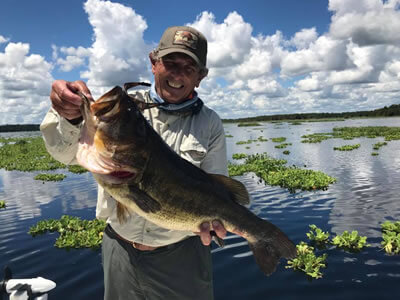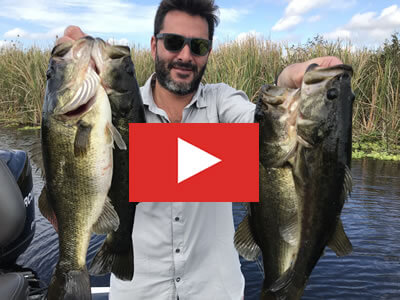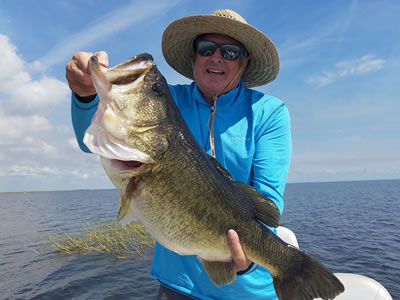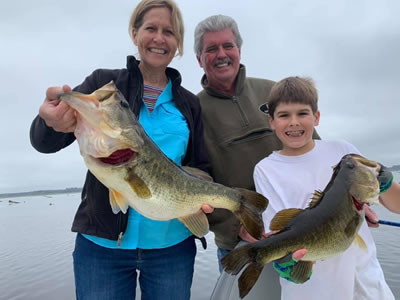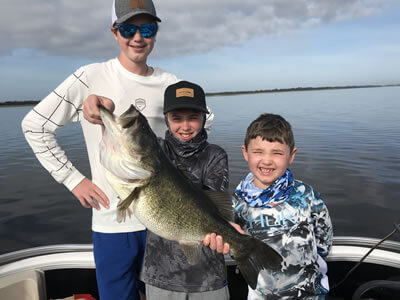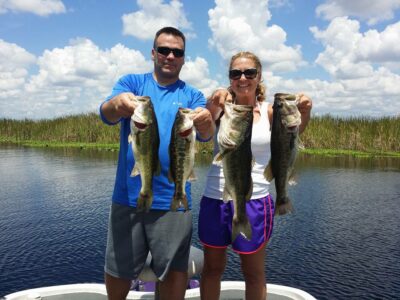Largemouth Bass

Micropterus Salmoides
Other Names: Black Bass, Trophy Bass, Lineside Bass, Green Trout, Bigmouth Bass
Description:
Key characteristic of this species is that they are generally light to dark green in color. Dark blotches formulate in a horizontal line on both sides of the fish. The underbelly generally is light green to white. Largemouth bass has a divided dorsal fin with the anterior containing nine spines and the posterior containing 12-13 soft rays. Their upper jaw also reaches far beyond the rear margin of the eye.
Florida and Texas rank as the TOP Destinations to explore and catch trophy largemouth bass in the United States!
FEEDING PATTERNS + HABITAT:
Each location and destination across the United States will have different forage for bass of all sizes. Most juvenile largemouth bass consumes mainly small insects, scuds, baitfish, and shrimp. As the bass becomes an adult, it will consume larger prey. This includes shad, bluegill, crawfish, snails, snakes, frogs, small water birds, baby alligators, and lizards. Larger lakes and reservoirs across the country with deeper water provide largemouth with a diet of mainly younger fish. These fish include shad, yellow perch, shiners, sunfish, and more. They will even consume trout, walleye, striped bass, and catfish.
Speed and Accuracy
Bass can devour a population of baitfish rather quickly. Lakes and fisheries with more vegetation and weeded cover provide a balanced ecosystem. It will also slow down the growth rate of the black bass. When looking to ambush prey, the bass will be sheltered in submerged structures, including drop-offs, weed beds, points, humps, and ridges. Brush and overhanging banks are other significant areas of focus. The black bass uses vibration, hearing, sight, and smell to seize its prey.
You can find bass in rivers, streams, lakes, and ponds worldwide. They preferably like non-flowing water with an abundance of vegetation. Clean and clear water also attracts more fish to its location. The Largemouth Bass is their habitat’s ultimate predator, but they can be preyed upon when younger!
LARGEMOUTH BASS SPAWN:
When it comes to the largemouth bass spawn, you can break it down into Pre-Spawn, Spawn, and Post-Spawn. All these spawning patterns are indicative of water temperatures. The sweet spot for most regions is around 55-65 degrees Fahrenheit. Once the temperatures reach this point, the bass will begin to spawn.
Male largemouth will prep the bed for the female bass. Once the female bass moves into the shallow water to lay her eggs, the male will stand guard for a period of time. The male does most of the work making sure that their young are safe.
When and Where?
Spawning areas are significantly noticeable when knowing what you are looking at. Large or small circles with white centers are indicative of a spawning bed. If it is empty, that bed is not active. During the peak of the year, you can generally find active and non-active areas of bedding.
Spawning for largemouth bass can occur multiple times a year especially if weather conditions are stable. It is important to maintain a conservation angling mind frame when looking to target bedding fish.
FISHING FOR BASS:
Fishing for largemouth bass is one of the most exciting forms of freshwater fishing. Hard-fights and big bass are what keeps anglers coming back for more, especially on Lake Okeechobee. Also, they become airborne in their efforts to spit the hook. Hard-fights, aerobatic movements, and trophy catch potential make largemouth the number one game fish. All across the world, you can have a blast catching this fish that comes in all sizes and habitats. Just like its predecessor, the smallmouth bass, is an additional catch to explore in the northern region of the United States!
ARTIFICIAL BAIT FISHING
Most anglers choose to fish for bass with artificial lures. The most common lure of choice is a soft-plastic worm or creature bait. Also, anglers have a blast catching bass on jigs, crankbaits, and spinnerbaits. Swimbaits and swim jigs also have become a very popular method to hunt down trophy largemouth bass, especially in Florida. Artificial fishing for largemouth bass can catch bass all summer long which keeps you addicted to bass fishing all across the nation and world. Quick and easy access to a wide range of waterways allows you to explore and catch largemouth bass all year round!
LIVE BAIT FISHING
When it comes to live bait fishing for largemouth bass, you have several options. Live bait, including minnows, frogs, crawfish, nightcrawlers, and earthworms, can be very productive in catching bass. One of the most common techniques to catch bass in Florida with live bait is the use of Golden Shiners. By far, it is one of the best ways to put trophy largemouth bass in the boat. Shiners, frogs, lizards, baby water birds, and bait fish are all common forage for black bass.
WHERE CAN YOU FISH FOR BASS:
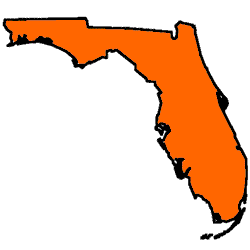
BASS IN FLORIDA

BASS IN MEXICO

BASS IN TEXAS

BASS IN CALIFORNIA
California has always been ranked as a TOP destination to catch largemouth bass in trophy-proportions. Fishing for bass has provided numerous economic and recreational values to the state can cities like Sacramento. You can catch a wide variety of species of bass in California including, Spotted bass and Smallmouth Bass!
FREQUENTLY ASKED QUESTIONS:
Recipes for largemouth bass?
Maecenas eu placerat ante. Fusce ut neque justo, et aliquet enim. In hac habitasse platea dictumst. Nullam commodo neque erat, vitae facilisis erat. Cras at mauris ut tortor vestibulum fringilla vel sed metus. Donec interdum purus a justo feugiat rutrum. Sed ac neque ut neque dictum accumsan. Cras lacinia rutrum risus, id viverra metus dictum sit amet.
Fusce venenatis, urna eget cursus placerat, dui nisl fringilla purus, nec tincidunt sapien justo ut nisl. Curabitur lobortis semper neque et varius. Etiam eget lectus risus, a varius orci. Nam placerat mauris at dolor imperdiet at aliquet lectus ultricies.
Duis tincidunt mi at quam condimentum lobortis.
Lures for largemouth bass?
Maecenas eu placerat ante. Fusce ut neque justo, et aliquet enim. In hac habitasse platea dictumst. Nullam commodo neque erat, vitae facilisis erat. Cras at mauris ut tortor vestibulum fringilla vel sed metus. Donec interdum purus a justo feugiat rutrum. Sed ac neque ut neque dictum accumsan. Cras lacinia rutrum risus, id viverra metus dictum sit amet.
Fusce venenatis, urna eget cursus placerat, dui nisl fringilla purus, nec tincidunt sapien justo ut nisl. Curabitur lobortis semper neque et varius. Etiam eget lectus risus, a varius orci. Nam placerat mauris at dolor imperdiet at aliquet lectus ultricies.
Duis tincidunt mi at quam condimentum lobortis.
Flies for largemouth bass?
Maecenas eu placerat ante. Fusce ut neque justo, et aliquet enim. In hac habitasse platea dictumst. Nullam commodo neque erat, vitae facilisis erat. Cras at mauris ut tortor vestibulum fringilla vel sed metus. Donec interdum purus a justo feugiat rutrum. Sed ac neque ut neque dictum accumsan. Cras lacinia rutrum risus, id viverra metus dictum sit amet.
Fusce venenatis, urna eget cursus placerat, dui nisl fringilla purus, nec tincidunt sapien justo ut nisl. Curabitur lobortis semper neque et varius. Etiam eget lectus risus, a varius orci. Nam placerat mauris at dolor imperdiet at aliquet lectus ultricies.
Duis tincidunt mi at quam condimentum lobortis.
Is it good to eat largemouth bass?
The largemouth bass is very popular to eat and very edible. Largemouth bass easily accessible through the world and provide tasty table food you’ll not forget. The largemouth bass has white flaky meat with a tender texture. In different parts of the world and even different parts of the United States the bass taste completely different. However, the taste of a largemouth will very bases on the water it lives in.
Its smell is on the fishy side, again this is based on the water temperature the bass lives is. For example, locations in the South where the water gets warm like the Florida Everglades in Southern Florida. The largemouth taste completely different in the Sumer verse the Winter. Most summertime largemouth bass get worms, more done as parasites. Why anglers still eat them in the summer, these parasites make the fish small more game then it normally is as well the meat will also have less texture during this time.
The good news, bass overall has a good texture and fewer bones than most fish leaving you with more meat. Overwhelmed with how to prepare it, the most popular way to cook it is to fry it with a batter of your choice. Grilling is always good, cuts down on the smell in the house, but beware the fish cooks fast. There are many other recipes here are a few of our favorites.
How to largemouth bass fish?
Maecenas eu placerat ante. Fusce ut neque justo, et aliquet enim. In hac habitasse platea dictumst. Nullam commodo neque erat, vitae facilisis erat. Cras at mauris ut tortor vestibulum fringilla vel sed metus. Donec interdum purus a justo feugiat rutrum. Sed ac neque ut neque dictum accumsan. Cras lacinia rutrum risus, id viverra metus dictum sit amet.
Fusce venenatis, urna eget cursus placerat, dui nisl fringilla purus, nec tincidunt sapien justo ut nisl. Curabitur lobortis semper neque et varius. Etiam eget lectus risus, a varius orci. Nam placerat mauris at dolor imperdiet at aliquet lectus ultricies.
Duis tincidunt mi at quam condimentum lobortis.
What largemouth bass eat?
What largemouth bass eat? If you are largemouth, smallmouth, or spotted bass, you eat anything that doesn’t try to eat you. This is good to know if you want to catch a bass, because with so many food choices, finding there favorite foods is sometimes not as easy as finding the local bait.
There are many studies on the internet of people examining the contents of the stomachs of bass to learn more about there favorite eating habits. The Florida Fish and Wildlife Commission is among the leaders in this department considering the biggest and best largemouth bass come from Florida stain bass. They concluded that not only can you determine what the largemouth bass eats, but as with humans is determines the health of the individual bass.
Even without biologists, we know that the diet of the bass is going to be based on the species of bait that live in the waters. Whether the body of water is stocked with shad, herring, trout, or alewives or it has a natural supply of shad, shiners, or crawfish. In most lakes, they don’t have enough food to grow trophy size. This is why, fisheries with a large supply of bait, typically have the bigger fish in your area.
This is why we know that bass also eats what foods are available at the given time. This could be a mouth, other insects, crayfish, frogs, lizards, snakes, other small fish all common for active bass 1 to 3 pounds in size. Larger bass even feeds on baby birds, big bluegills, crappie, and ducks for dinner. It’s also not uncommon for larger bass to eat smaller bass if they feel it is necessary. Survival is the name of the game in the wild.
A lot of the diet is also determined how hard they have to work for it. So if it swims in front of their mouths, it may have just moved up the food change for that day. Largemouth bass especially chooses their meals based on their size, as he grows so does the size of his attacks. This is also very true with Alligators, it’s easier to hunt and eat one big meal.
An example of this would be the largemouth bass in California often eat rainbow trout 8 to 12 inches long. In Florida, it’s not uncommon to find big largemouth bass with 10 to 12-inch gizzard shad in its mouth. Again to properly understand the bass, you must understand the same bass with a 10″ shad in his stomach will have tiny grass shrimp, and minors as proof that bass will eat what nearby when they get hungry.
A condenses around the country, by lure sales. If there were one choice for bass, it would be a threadfin shad. You can find them in bass stomachs all across the country, they are easier to catch, easier to digest. Which means they can eat more of them.
Bass don’t eat plants and don’t need nutrition from plant matter. They are meat-eaters only!
Where do largemouth bass live?
As the largest guide service in the nation for largemouth bass, we have developed data that there are two basic patterns of bass in every body of water. And when we’re expanding to new areas we start with the easy group first. Known as resident fish.
Resident bass lives in an area all year long, before, and after they spawn, they never leave. These areas could be a main-lake point, grass flats, or a back of a creek. Most local marinas have resident bass under docks and laydowns. For the most part, they never leave there comfort zone for deeper water and are very protective of there area.
They have enough food to eat locally, there’s generally a place to spawn nearby. They are also protected from bigger predators. They have grown there and the habitat suits them, and don’t desire anything else to survive.
Majority of anglers, start by fishing resident fish and don’t know it. That why once you stumble across an area you can catch fish every time you go back. Targeting these fish is an excellent way to enjoy bass fishing and guarantee consistent success. They’ll give you enough action every recreational angler will have fun.
The problem for most anglers are the resident fish aren’t always the biggest and if there is a limited number compared to the family of fish living on the lake.
This second group is the largest population on most bodies of water, lakes like Okeechobee have an overwhelming majority of roamers. These fish live to eat, they don’t really live anywhere. They roam in pairs and schools chasing baitfish, shad, shiners, or crayfish. The only exception is during the spawning months. That’s why a cover can go from no fish to spawning fish everywhere in one day. These are main lake fish, typically lighter in color then a resident fish.
Roamers don’t live in the deeper water or the shallow, they tend to travel where the bait goes and the group. These fish you catch really good today and go back tomorrow and they are gone. But you can pattern these fish over time and with history. For example, you know how the fish school every summer on the point and there for two weeks? The way to pattern roamers to understand where they go and consequentially build a month by month pattern of there migration.
In almost all cases fish are going to be bigger and fight harder than the resident bass. Simply because they eat more and exercise every day. We have no idea why this happens, we just can say we have been going from lake to lake for over 20 years learning the patterns as a business and this is what te data shows as the results we get on our guided trips.
Think about this when fishing your favorite local lake, it works and we hope it does for you!
MORE INFORMATION ABOUT LARGEMOUTH BASS:
Fun Facts:
- Bass can eat prey up to 35% of their body length
- Average life span is 10-16 years
- Two world-record bass were caught and declared a tie weighing at 22-pounds, 4 ounces.
- Largemouth bass use scent mainly to attack and ambush prey
- Females can lay a large number of eggs between 2,000-40,000 eggs
Records:
- World: 22-pounds, 4-ounce on Lake Montgomery in 1932
- Florida: 17-pounds, 4-ounces on a private lake, 1986
- Texas: 18-pounds, 2.8 ounces on Lake Fork, 1992
- California: 21-pounds, 12 ounces on Lake Castaic, 1991
Fishing Techniques:
- Light Tackle
- Heavy Tackle
- Livebait
- Fly Fishing
- Artificial Lures
Fishing Equipment:
- Spinning Rods
- Baitcasting Rods
- Left & Right Handed
- Fly Rods (request only)
- Braid & Mono Line

